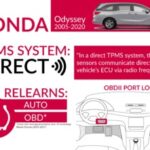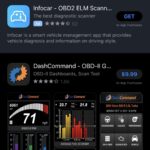Are you struggling to get your 2002 Hyundai Sonata to complete its OBD2 drive cycle? Many Sonata owners face this frustrating issue when preparing for an emissions test or after performing car maintenance. The OBD2 system, or On-Board Diagnostics II, is crucial for monitoring your vehicle’s emissions system and ensuring it’s running cleanly. When the drive cycle isn’t complete, certain monitors remain in a “Not Ready” state, which can lead to failing an emissions test, even if there are no obvious mechanical problems.
Understanding why your 2002 Hyundai Sonata won’t complete the OBD2 drive cycle is the first step in resolving this issue. This article will delve into the common reasons behind this problem and provide you with a step-by-step guide to perform the Hyundai Sonata drive cycle effectively.
What is an OBD2 Drive Cycle and Why is it Important?
The OBD2 system is designed to monitor various components of your car’s engine and emissions system. To ensure these systems are functioning correctly after repairs or a battery disconnect, the OBD2 system needs to run a series of self-tests known as “monitors.” These monitors, such as the oxygen sensor monitor, evaporative system monitor, and catalyst monitor, need to complete their tests and switch to a “Ready” status. The process that allows these monitors to run and complete is called the OBD2 drive cycle.
If these monitors are not in a “Ready” state, your vehicle might not pass an emissions test, even if there are no active check engine lights. This is because the system hasn’t confirmed that all emissions components are working as they should.
The Hyundai Sonata Drive Cycle Procedure
To initiate the OBD2 drive cycle on your 2002 Hyundai Sonata, follow these steps. It’s crucial to perform these steps precisely for the cycle to be effective.
STEP 1: Preparation
- Check Engine Light and Trouble Codes: Before starting, ensure the check engine light is off and there are no stored Diagnostic Trouble Codes (DTCs). Use an OBD2 scanner to check for any codes. If any faults are found, address and repair them first. Clearing codes without fixing the underlying issue will only restart the process and not solve the problem.
- Fuel Level: Ensure your fuel tank is between 1/4 and 3/4 full. This is important for the evaporative emissions system monitor to run correctly.
- Cold Start: Start with a cold engine. The engine should be completely cooled down for several hours, ideally overnight.
STEP 2: Initial Idle
- Start the engine and let it idle in Park (P) for 1.5 minutes (90 seconds). Do not touch the accelerator pedal.
STEP 3: Steady State Driving – Part 1
- Within 15 seconds, gently accelerate to a speed between 50-55 mph (80-88 km/h) using approximately 1/4 to 3/4 throttle. Maintain this steady speed for 2-3 minutes.
- Safely decelerate to 0 mph without using the brake pedal. Allow the car to coast down.
- Idle the engine in Drive (D) for 1-2 minutes.
STEP 4: Steady State Driving – Part 2
- Again, within 15 seconds, accelerate to 50-55 mph (80-88 km/h) using 1/4 to 3/4 throttle. Maintain this constant speed for a longer duration, this time for 10-20 minutes.
- Decelerate to 0 mph without braking, allowing the vehicle to coast to a stop.
- Idle the engine in Drive (D) for 1-2 minutes.
STEP 5: Completion
- Turn off the engine and switch the ignition key to the OFF position. The Hyundai Sonata OBD2 drive cycle is now complete.
After completing these steps, use an OBD2 scanner to check the status of your vehicle’s monitors. Ideally, all or most of the monitors should now show a “Ready” status. You may need to repeat the drive cycle a few times if some monitors are still “Not Ready.”
Why Your 2002 Hyundai Sonata OBD2 Drive Cycle Might Not Complete
Even after diligently following the drive cycle, you might find that your 2002 Hyundai Sonata still won’t complete the OBD2 drive cycle. Here are some common reasons:
- Underlying Mechanical or Sensor Issues: If there are unresolved issues with your engine or emissions system, the monitors may not be able to complete their tests. For example, a faulty oxygen sensor, MAF sensor, or vacuum leaks can prevent the system from achieving a “Ready” state. In the original post, the user experienced a P0172 “System Too Rich” code, which could indicate a problem with the MAF sensor or O2 sensor, potentially hindering the drive cycle completion even after clearing the code.
- Incorrect Drive Cycle Execution: Precision is key when performing a drive cycle. Variations in speed, acceleration, deceleration, or idle times can prevent the monitors from running correctly. Ensure you are maintaining the specified speeds and times as accurately as possible.
- Faulty Sensors: Even without triggering a check engine light, a sensor might be failing or providing inaccurate readings. This can disrupt the drive cycle process. Sensors like the oxygen sensors, mass airflow sensor, and coolant temperature sensor are critical for emissions monitoring.
- Battery Issues: A weak or failing battery can sometimes interfere with the OBD2 system’s ability to run its monitors. Ensure your battery is in good condition and properly charged.
- Aggressive Driving Habits: Avoid sudden acceleration or hard braking during the drive cycle, as this can interrupt the testing process. Smooth and consistent driving is essential.
Troubleshooting Tips and Next Steps
If your 2002 Hyundai Sonata OBD2 drive cycle is not completing, consider these troubleshooting steps:
- Re-examine for Trouble Codes: Even if the check engine light is off, re-scan for pending or intermittent codes that might not be illuminating the light but are still preventing monitor readiness.
- Inspect Sensors: If you suspect a sensor issue, especially if you’ve had related codes in the past (like P0172), consider inspecting or testing the MAF sensor and oxygen sensors.
- Check for Vacuum Leaks: Vacuum leaks can affect fuel trims and emissions, potentially preventing drive cycle completion. Inspect vacuum lines for cracks or disconnections.
- Battery Health: Have your battery tested to rule out a weak battery as a contributing factor.
- Professional Diagnostic Scan: If you’ve tried the drive cycle multiple times and checked for obvious issues, it’s advisable to take your Hyundai Sonata to a qualified mechanic. They have advanced diagnostic tools to pinpoint the exact reason why your drive cycle is not completing.
Conclusion
Getting your 2002 Hyundai Sonata to complete the OBD2 drive cycle is crucial for passing emissions tests and ensuring your vehicle is running efficiently. By understanding the drive cycle procedure and common reasons for failure, you can systematically troubleshoot the issue. Remember to perform the drive cycle accurately, address any underlying mechanical problems, and don’t hesitate to seek professional help if needed. With patience and persistence, you can get your Sonata’s OBD2 system ready and keep it running smoothly.

